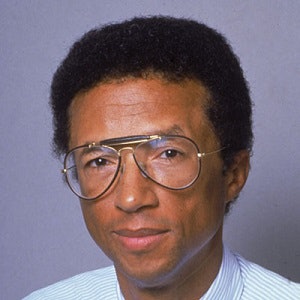RICHMOND, Va. — Greg Rogers hadn’t even been born yet when one of the nation’s most prolific athletes — Arthur Robert Ashe, Jr. — died.
But Rogers, who grew up in Richmond — the city where Ashe began practicing his craft at the age of 7 — has aspirations of following in his hero’s footsteps.
 Arthur Ashe
Arthur Ashe“I’ve read everything written about him and watched old footage of him playing on the courts,” says Rogers, 17, who lives in the same neighborhood that Ashe once lived in with his parents and younger brother. “He was not only an amazing tennis player, but he was a leader in the fight against racism.”
Indeed, this year marks the 25th anniversary of Ashe’s death.
The professional tennis player, who won three Grand Slam titles and was the first Black man to ever win the singles title at Wimbledon, died from AIDS-related pneumonia. He was just 49 years old.
Ashe had contracted the virus from a blood transfusion that he received during heart bypass surgery and became a stalwart in the fight against the disease, creating the Arthur Ashe Foundation for the Defeat of AIDS and the Arthur Ashe Institute for Urban Health.
Sitting near the bronze statue on Monument Avenue in Richmond that bears Ashe’s likeness, Rogers represents a younger generation that admires the activism that Ashe exuded.
“He stood for something,” says Rogers. “He didn’t just settle for being famous. He used his fame to help other people.”
That’s certainly true, says Donald Dell, a former professional tennis player who also served as Ashe’s lawyer for a short time.
“Far too many of today’s elite athletes seem to run away from the pressures of being a role model, but he embraced it,” says Dell, who shared a long friendship with the tennis great.
“He was a true humanitarian, launching or working on behalf of a range of causes,” says Dell, adding that Ashe was committed to creating tennis and sports opportunities for underserved youth.
In the 1980s, Ashe was part of a growing movement against apartheid in South Africa. This became a longtime passion for which he protested often, more than once being led away in handcuffs.
According to Dell, Ashe “took up the cause of public health when the heart disease that ran in his family struck him, and again when he contracted HIV during a second open heart surgery, making it his mission — his last — to alleviate the fear of the disease and those with AIDS.”
While Ashe is most admired for his athleticism on the court and his activism off, Tom Chewning, who met Ashe in 1959 at a junior tournament in West Virginia and remained friends with the tennis player until his death, says that the UCLA graduate had political aspirations.
“I think he might well have been a diplomat,” says Chewning, a retired chief financial officer at Dominion Resources. “I don’t think he wanted to be a business mogul. He certainly had enough financial acumen to take care of himself and his family, but I think he wanted to do something to serve the world.”
According to those who knew him, Ashe once contemplated running for Congress and believed that public service by way of political office was one way to have an impact.
“Arthur always wanted very much to be in politics,” says Dell. “He was a great friend of David Dinkins, the Black mayor of New York City. I always think, looking back, that Arthur was kind of the forerunner to Barack Obama.”
His life and sports acumen would inspire tennis greats like Serena and Venus Williams and countless others aspiring to be just like him.
“Just like Muhammad Ali changed the world and became one of the greatest fighters and humanitarians of all time, you can’t write the history of sports, in my opinion, without giving Arthur Ashe his due,” says Rogers, who notes that the city recently unveiled a new mural to honor their favorite son. “When you think about all that he had to go through, and he still achieved greatness, there really is no limit to what we can achieve.”
Indeed, historians recall that, despite Ashe not being allowed to use Richmond’s Whites-only tennis courts as a child, he remained committed to the principles of inclusion and diversity and never stopped pushing forward.
“Arthur Ashe was unlike any Black athlete before him and since,” says Dr. Eric Hall, an associate professor of history at Northern Illinois University, who has written a book on Ashe. “A voracious reader and public intellectual, he could easily have been a college professor or CEO. Few athletes — Black and White — commanded as much respect.”
Hall said that even though Ashe visited South Africa, he went on his own terms, refusing to play before a segregated crowd and demanding to talk with Black reporters.
“On the court, Ashe was a gentleman’s gentleman,” says Hall. “He didn’t curse, throw his racquet, showboat or lose his temper. He defied almost every Black athletic stereotype — he controlled his emotions, outsmarted Jimmy Connors at Wimbledon in 1975 and displayed a level of intellectualism mostly absent from athletics. He used his platform to do good, plain and simple.”
This article appeared in the April 5, 2018 issue of Diverse magazine.



















